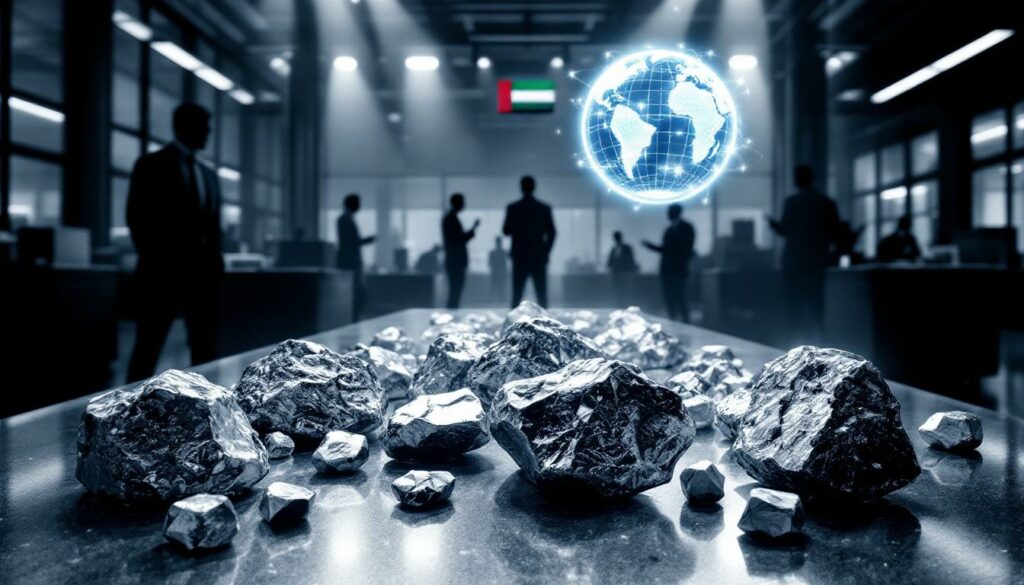Understanding the Trafigura Nickel Fraud Scandal
The global commodities market was rocked by one of the largest trading frauds in recent memory when Trafigura Group, a leading commodity trading giant, fell victim to a sophisticated nickel fraud scheme. This scandal, resulting in losses exceeding $500 million, has raised serious questions about verification processes in commodity trading while highlighting vulnerabilities that exist within global supply chains.
The $500+ Million Nickel Fraud
In early 2023, Trafigura Group made the shocking announcement that it had discovered multiple shipments it had purchased supposedly containing nickel actually contained no nickel at all. The company had been deceived into purchasing worthless material instead of the valuable industrial metal, resulting in losses that ultimately exceeded half a billion dollars.
The scale of this deception makes it one of the most significant commodity trading frauds in recent years, comparable to other major market scandals but unique in its execution and scale within the metals trading sector.
"Trafigura revealed it had lost more than $500 million following its purchase of nickel cargoes that didn't contain the metal." – Bloomberg News
This fraud exploited fundamental vulnerabilities in commodity verification systems, revealing how even sophisticated trading operations with extensive experience can fall victim to well-orchestrated deception schemes.
Key Players in the Scandal
Several key individuals and organizations stand at the center of this complex fraud case:
-
Prateek Gupta: The businessman accused by Trafigura of masterminding the elaborate fraud scheme involving the fake nickel shipments
-
Harshdeep Bhatia: Former Trafigura trader who led the company's relationship with Gupta and was described in legal filings as the "main trader" working with him
-
Trafigura Group: One of the world's largest commodity trading companies and the victim of the alleged fraud
-
International Resources Holding (IRH): Abu Dhabi-based company that hired Bhatia as head of base metals in June 2025, despite his previous involvement with the scandal
-
Citigroup: Financial institution that reportedly played a significant role in helping to uncover the fraud through their compliance and transaction monitoring systems
The relationship dynamics between these players, particularly the "apparent 'cosiness'" between Bhatia and Gupta noted in legal filings, have become central to understanding how the fraud was perpetrated and why it remained undetected for so long.
Timeline of Events
The Trafigura nickel fraud case has unfolded over several years:
-
Pre-2023: Trafigura purchased what it believed were nickel shipments from entities connected to Prateek Gupta
-
Early 2023: Trafigura discovered the fraud with assistance from Citigroup and announced losses exceeding $500 million
-
Early 2023: Harshdeep Bhatia left Trafigura following the revelation of the fraud
-
2023-2025: Legal proceedings against Gupta commenced, including asset freezes and preliminary hearings
-
June 2025: Bhatia joined Abu Dhabi's IRH as head of base metals despite his previous connection to the scandal
-
November 2025: Major trial against Gupta scheduled to begin in London, which will likely determine legal responsibility and potential recovery of assets
This timeline reveals the ongoing nature of the case, with significant legal proceedings still ahead and important questions about accountability yet to be resolved.
How Was the Nickel Fraud Executed?
The Alleged Scheme
The fraud allegedly centered on a sophisticated substitution scheme. Entities connected to Prateek Gupta reportedly sold Trafigura shipments that were supposed to contain high-grade nickel but actually contained worthless materials. Court documents have highlighted that the success of this scheme relied heavily on exploiting established relationships and trust within the commodity trading ecosystem.
Legal filings noted an "apparent 'cosiness'" in the relationship between Bhatia and Gupta, suggesting that personal relationships may have been leveraged to circumvent standard verification procedures. This dynamic potentially created an environment where normal due diligence measures were relaxed or bypassed entirely.
Despite these concerning relationship dynamics, Trafigura has not accused Bhatia of wrongdoing and has stated it doesn't believe any of its employees were complicit in the fraud. This position suggests the company views itself as a victim of external deception rather than internal malfeasance.
Gupta's Counterclaims
Prateek Gupta has mounted an aggressive defense, making several counterclaims suggesting that Trafigura traders were aware that the containers did not contain nickel. These allegations, if proven, would significantly alter the narrative around the fraud and potentially shift legal liability.
However, these claims were dismissed by a judge who concluded Gupta had not presented sufficient evidence to demonstrate this knowledge. The court rejected Gupta's attempt to have a freeze on his assets lifted, finding his counterclaims lacked substantive supporting evidence.
Gupta has also claimed that Trafigura itself "devised" the nickel scheme, essentially arguing that the company was not a victim but an architect of the arrangement. These allegations remain unproven and have been strongly denied by Trafigura.
Citigroup's Role in Uncovering the Fraud
Financial institution Citigroup reportedly played a significant role in helping to uncover the fraud, demonstrating the critical function that financial institutions can serve in detecting irregularities in commodity trading transactions.
While specific details of Citigroup's detection methods remain undisclosed, financial institutions typically employ sophisticated transaction monitoring systems that can flag unusual patterns, unexpected trading volumes, or suspicious documentation. These systems serve as an important secondary line of defense when primary verification procedures fail.
The involvement of Citigroup highlights how the modern commodity trading ecosystem relies on multiple layers of oversight, with financial institutions often positioned to detect anomalies that might escape notice during physical commodity inspections or documentation reviews.
What Are the Legal Proceedings and Consequences?
Current Legal Status
The case against Prateek Gupta is scheduled for trial in London starting in November 2025. This extensive timeline—with the trial beginning almost three years after the fraud's discovery—reflects the complex nature of international commodity fraud cases and the extensive pre-trial procedures required.
The upcoming trial represents a critical juncture in determining legal responsibility for the alleged fraud and potential recovery of assets. It will likely establish important precedents for how similar cases are handled in the future and may influence industry practices regarding verification and due diligence.
"Gupta had not presented sufficient evidence to demonstrate [Trafigura's] knowledge." – Court ruling cited by Bloomberg News
The court's eventual findings will have significant implications not only for the parties directly involved but for commodity trading practices more broadly.
Asset Freezes and Legal Maneuvers
In an attempt to protect potential recovery options, Trafigura secured freezes on Gupta's assets early in the legal process. These asset freezes represent standard procedure in cases involving alleged fraud of this magnitude, designed to prevent the dissipation of assets that might later be subject to recovery orders.
Gupta attempted to have the freeze on his assets lifted based on his claim that Trafigura traders were aware the containers did not contain nickel. However, this attempt was dismissed by a judge who found insufficient evidence to support Gupta's claims, leaving the asset freeze in place pending the full trial.
These preliminary legal battles offer a preview of the arguments likely to feature prominently in the main trial, with Gupta's defense strategy appearing to center on allegations of Trafigura's complicity rather than denial of the basic facts regarding the shipments' contents.
Industry-Wide Implications
The scandal has raised serious concerns about verification processes in commodity trading and highlighted vulnerabilities in supply chain documentation and physical commodity verification procedures. The case demonstrates how even sophisticated market participants can fall victim to fraud when verification protocols are inadequate or inconsistently applied.
Industry experts suggest this case may lead to stricter verification requirements and more robust due diligence processes throughout the commodity trading sector. Potential reforms might include:
- Enhanced physical inspection requirements for high-value commodities
- More rigorous documentation verification procedures
- Increased use of technology solutions like blockchain to create immutable transaction records
- Greater scrutiny of long-standing trading relationships that might otherwise bypass standard controls
These changes would represent significant shifts in industry practice, potentially increasing transaction costs but reducing vulnerability to similar fraud schemes.
Who is Harshdeep Bhatia and What's His New Role?
Bhatia's Position at Trafigura
Harshdeep Bhatia was described in legal filings as the "main trader" working with Prateek Gupta during the period when the fraudulent nickel shipments were purchased. Court documents noted an "apparent 'cosiness'" in their relationship, suggesting a level of familiarity that has raised questions about oversight and verification procedures.
Despite these concerning characterizations in legal documents, Trafigura has not accused Bhatia of wrongdoing or complicity in the fraud. The company's position appears to be that Bhatia, like Trafigura itself, was deceived by Gupta rather than participating in the deception.
This nuanced stance highlights the complex nature of responsibility and culpability in commodity trading relationships, where close professional relationships are common but can sometimes create vulnerabilities in control systems.
Transition to IRH
After leaving Trafigura in early 2023 following the revelation of the fraud, Bhatia made a surprising career move. In June 2025, he joined International Resources Holding (IRH) as head of base metals, taking on a senior role at an organization that has been aggressively expanding its presence in the global metals and mining sector.
This appointment came despite Bhatia's connection to one of the largest commodity trading frauds in recent history, raising questions about IRH's due diligence processes and risk appetite. The willingness to hire an executive with ties to such a significant scandal suggests either exceptional confidence in Bhatia's innocence or a strategic calculation that his expertise outweighs potential investment red flags.
"Bhatia has joined IRH as head of base metals… as the company and its parent conglomerate push ahead with an acquisition spree." – Bloomberg News
Bhatia's transition demonstrates how industry relationships and specialized expertise can sometimes transcend reputational challenges, particularly in a sector where specialized knowledge is highly valued.
IRH's Strategic Expansion
Bhatia's appointment comes amid an aggressive acquisition strategy by IRH and its parent conglomerate. The company has been systematically expanding its presence in the metals and mining sector through strategic acquisitions of major assets.
This hiring decision appears aligned with IRH's broader strategy of building a comprehensive metals trading and production portfolio. Bhatia's experience in base metals trading, despite the controversy surrounding the nickel fraud case, likely represents valuable expertise for an organization with ambitious growth plans in the sector.
The appointment also reflects the competitive landscape for experienced commodities trading talent, where individuals with specific market knowledge and relationship networks remain highly sought after despite potential reputational concerns.
What is International Resources Holding (IRH)?
Company Background and Ownership
IRH is a unit of International Holding Co. (IHC), a vast conglomerate controlled by United Arab Emirates National Security Adviser Sheikh Tahnoon Bin Zayed Al Nahyan. The organization represents a significant projection of UAE strategic interests into global resource markets.
As part of the broader IHC corporate structure, IRH benefits from substantial financial resources and political connections that have enabled its rapid expansion in the global metals and mining industry. This backing has positioned IRH as an emerging power player in resource markets despite its relatively recent entry into the sector.
The company's ownership structure reflects a growing trend of sovereign-linked entities taking strategic positions in critical mineral supply chains, often with objectives that blend commercial interests with national strategic priorities around resource security.
Recent Acquisitions
IRH has been on an aggressive acquisition spree in recent years, systematically building a portfolio of strategic metal and mining assets:
-
In June 2025, it agreed to acquire a majority stake in Alphamin Resources Corp., which owns one of the world's biggest tin mines
-
Previously acquired Zambia's Mopani copper complex, a significant copper production asset in a region of growing strategic importance
-
Continues to evaluate additional acquisition targets across various metal and mining sectors
These acquisitions reflect a coherent strategy of securing positions in both traditional base metals (copper) and specialty metals (tin) that are critical for industrial applications and energy transition technologies.
Strategic Positioning in Global Markets
IRH's hiring of Bhatia and its continued acquisitions suggest a strategic positioning to become a dominant player in global metals markets. The company appears particularly focused on critical and base metals that are essential for energy transition technologies and industrial applications.
This strategy aligns with broader UAE economic diversification initiatives aimed at reducing dependence on hydrocarbon revenues by establishing positions in future-oriented industries and supply chains. The focus on metals that are essential for renewable energy technologies and electric vehicles positions IRH at the intersection of traditional resource extraction and emerging green economy supply chains.
"IRH has been one of the most aggressive buyers of assets in the metals and mining industry in recent years." – Bloomberg News
The company's approach represents a sophisticated blend of financial investment and strategic resource positioning, with potential implications for global supply chains and market dynamics in critical minerals.
How Has the Nickel Market Responded?
Market Impact of the Fraud
The revelation of such a significant fraud in the nickel market had ripple effects throughout the commodity trading sector. The incident raised serious questions about verification processes and potentially affected market confidence in nickel trading, particularly for transactions involving less established counterparties or complex supply chains.
The discovery that such a major player could be deceived into purchasing fake nickel highlighted vulnerabilities in the commodity trading ecosystem that many market participants had previously underestimated. This realization likely prompted reassessment of risk controls throughout the industry.
Market participants have likely become more cautious in their trading relationships, potentially increasing transaction costs as additional verification procedures are implemented. This heightened vigilance represents a natural market response to the realization that even sophisticated trading houses can fall victim to fraud.
Changes in Trading Practices
Following the scandal, industry participants have likely implemented more stringent verification procedures for physical commodity deliveries. These enhanced processes may include:
- More frequent physical inspections of commodity shipments
- Enhanced documentation requirements with multiple verification points
- Greater scrutiny of new trading relationships and counterparties
- Regular auditing of long-standing trading relationships that might otherwise escape routine verification
These changes represent a recalibration of the balance between operational efficiency and risk management, with market participants accepting some additional friction in trading processes as a necessary cost of fraud prevention.
Nickel Price Volatility
The nickel market has experienced significant volatility in recent years, with the Trafigura fraud adding another layer of uncertainty to an already dynamic market. Prices have fluctuated due to a combination of factors:
- Supply concerns related to export restrictions in major producing countries
- Shifting demand patterns in the electric vehicle sector
- Confidence issues related to trading integrity following the fraud revelation
- General macroeconomic factors affecting industrial metals
While direct price impacts specifically attributable to the fraud are difficult to isolate, the incident contributed to an environment of heightened market uncertainty and potentially influenced trading patterns, particularly for physical nickel deliveries where verification concerns became more prominent.
FAQs About the Trafigura Nickel Fraud
What exactly was substituted for nickel in the fraudulent shipments?
While specific details about the substitute materials have not been fully disclosed in public reports, commodity fraud typically involves substituting lower-value materials that have similar weight or appearance to the purported commodity. In metal trading frauds, this often means using:
- Lower-grade metals with similar appearance
- Industrial waste products with appropriate weight characteristics
- Processed materials designed to mimic the appearance of the genuine commodity
The sophistication of the substitution likely contributed to the fraud remaining undetected through multiple shipments, suggesting careful selection of substitute materials that could pass visual inspection or basic testing procedures.
Has Trafigura recovered any of the $500+ million lost?
The public information available does not specify how much, if any, of the $500+ million Trafigura has recovered. The outcome of the November 2025 trial may determine whether the company can recover additional funds through legal remedies.
Recovery efforts in such cases typically follow multiple paths:
- Asset recovery through legal proceedings against the alleged perpetrators
- Insurance claims for covered losses
- Internal write-downs of unrecoverable amounts
The extended timeline between the fraud's discovery and the upcoming trial suggests that immediate recovery options may have been limited, with Trafigura likely focusing on the legal process as its primary recovery mechanism.
Could this type of fraud happen again in commodity markets?
While trading houses have likely strengthened verification procedures following this high-profile case, commodity markets remain vulnerable to sophisticated fraud schemes. The physical nature of commodities and complex global supply chains create inherent verification challenges that cannot be entirely eliminated.
Several factors contribute to ongoing vulnerability:
- The high volume and value of commodity transactions make comprehensive verification economically challenging
- Global supply chains involve multiple jurisdictions with varying regulatory standards
- Close trading relationships can sometimes lead to relaxed verification procedures
- Sophisticated fraudsters continue to develop new methods to circumvent controls
Reducing fraud risk requires continuous improvement of verification procedures and vigilance against complacency, particularly in long-standing trading relationships where controls might otherwise be relaxed.
What red flags might have indicated the fraud earlier?
Potential warning signs that might have indicated the fraud earlier include:
- Pricing inconsistencies: Unusual discounts or pricing that deviates from market benchmarks
- Documentation irregularities: Inconsistencies in shipping documents, certificates of analysis, or origin documentation
- Unusual trading patterns: Sudden increases in volume or changes in typical trading behavior
- Relationship dynamics: The "apparent 'cosiness'" noted in court documents between
Want to Invest in the Next Major Mineral Discovery?
Don't miss out on significant ASX mineral discoveries that could generate substantial returns. Visit Discovery Alert's dedicated discoveries page to explore how their proprietary Discovery IQ model transforms complex mineral data into actionable insights, giving you a market-leading advantage with real-time alerts.




